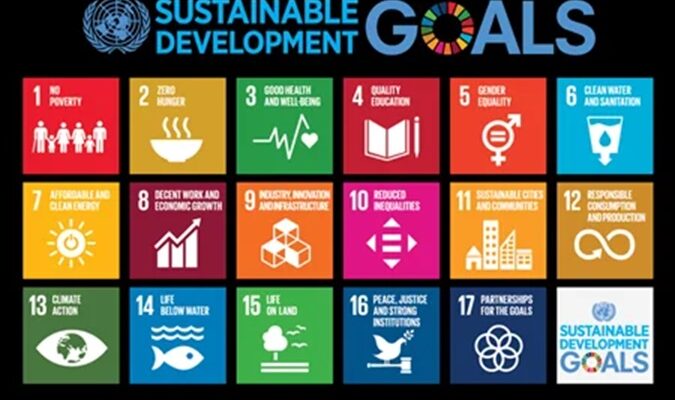Spread the love
The 17 Sustainable Development Goals (SDGs) are a global call to action to end poverty, protect the planet, and ensure peace and prosperity for all. Implementing these goals is crucial for uplifting the standard of living for people around the world. Here’s an overview of each goal, implementation strategies, and their importance:
Goal 1: No Poverty
- Implementation Strategy: Implement social protection programs, promote economic growth, and provide access to education and job training.
- Importance: Eradicating poverty ensures that everyone has access to basic needs, improving overall well-being and quality of life.
Goal 2: Zero Hunger
- Implementation Strategy: Promote sustainable agriculture, improve food distribution, and support small-scale farmers.
- Importance: Ending hunger ensures that everyone has access to nutritious food, improving health and productivity.
Goal 3: Good Health and Well-being
- Implementation Strategy: Strengthen healthcare systems, promote preventive healthcare, and address mental health.
- Importance: Ensuring good health and well-being improves quality of life, increases productivity, and reduces healthcare costs.
Goal 4: Quality Education
- Implementation Strategy: Improve access to quality education, promote lifelong learning, and support teacher training.
- Importance: Quality education improves employability, increases economic opportunities, and promotes social mobility.
Goal 5: Gender Equality
- Implementation Strategy: Promote equal rights, address gender-based violence, and support women’s empowerment.
- Importance: Achieving gender equality promotes social justice, improves economic opportunities, and enhances overall well-being.
Goal 6: Clean Water and Sanitation
- Implementation Strategy: Improve access to clean water, promote water conservation, and enhance sanitation infrastructure.
- Importance: Ensuring access to clean water and sanitation improves health, reduces water-borne diseases, and promotes economic productivity.
Goal 7: Affordable and Clean Energy
- Implementation Strategy: Promote renewable energy, improve energy efficiency, and increase access to energy.
- Importance: Ensuring access to affordable and clean energy reduces greenhouse gas emissions, improves air quality, and promotes economic growth.
Goal 8: Decent Work and Economic Growth
- Implementation Strategy: Promote entrepreneurship, improve labor standards, and support economic diversification.
- Importance: Ensuring decent work and economic growth promotes economic opportunities, improves living standards, and reduces poverty.
Goal 9: Industry, Innovation, and Infrastructure
- Implementation Strategy: Invest in infrastructure, promote innovation, and support sustainable industrialization.
- Importance: Building resilient infrastructure and promoting innovation improves economic competitiveness, creates jobs, and enhances overall development.
Goal 10: Reduced Inequalities
- Implementation Strategy: Promote social inclusion, address income inequality, and support marginalized groups.
- Importance: Reducing inequalities promotes social justice, improves economic opportunities, and enhances overall well-being.
Goal 11: Sustainable Cities and Communities
- Implementation Strategy: Promote sustainable urban planning, improve access to housing, and enhance public transportation.
- Importance: Creating sustainable cities and communities improves quality of life, reduces environmental impacts, and promotes economic growth.
Goal 12: Responsible Consumption and Production
- Implementation Strategy: Promote sustainable consumption patterns, reduce waste, and support eco-friendly practices.
- Importance: Ensuring responsible consumption and production reduces environmental impacts, conserves resources, and promotes sustainable development.
Goal 13: Climate Action
- Implementation Strategy: Reduce greenhouse gas emissions, promote renewable energy, and support climate-resilient infrastructure.
- Importance: Taking action on climate change reduces environmental impacts, promotes sustainable development, and ensures a livable future.
Goal 14: Life Below Water
- Implementation Strategy: Protect marine ecosystems, promote sustainable fishing, and reduce pollution.
- Importance: Conserving life below water promotes biodiversity, supports fisheries, and enhances overall ecosystem health.
Goal 15: Life on Land
- Implementation Strategy: Protect terrestrial ecosystems, promote sustainable land use, and address desertification.
- Importance: Conserving life on land promotes biodiversity, supports ecosystem services, and enhances overall environmental health.
Goal 16: Peace, Justice, and Strong Institutions
- Implementation Strategy: Promote peace and stability, strengthen institutions, and ensure access to justice.
- Importance: Ensuring peace, justice, and strong institutions promotes social stability, reduces conflict, and enhances overall development.
Goal 17: Partnerships for the Goals
- Implementation Strategy: Foster global partnerships, promote cooperation, and support capacity building.
- Importance: Building partnerships for the goals promotes collaboration, enhances resource mobilization, and supports sustainable development.
Implementing the 17 SDGs requires a collective effort from governments, businesses, civil society, and individuals. By working together, we can create a better future for all and uplift the standard of living for people around the world.
– Benjamin Ibrahim, a retired Permanent Secretary, writes from Lokoja.
Spread the love





